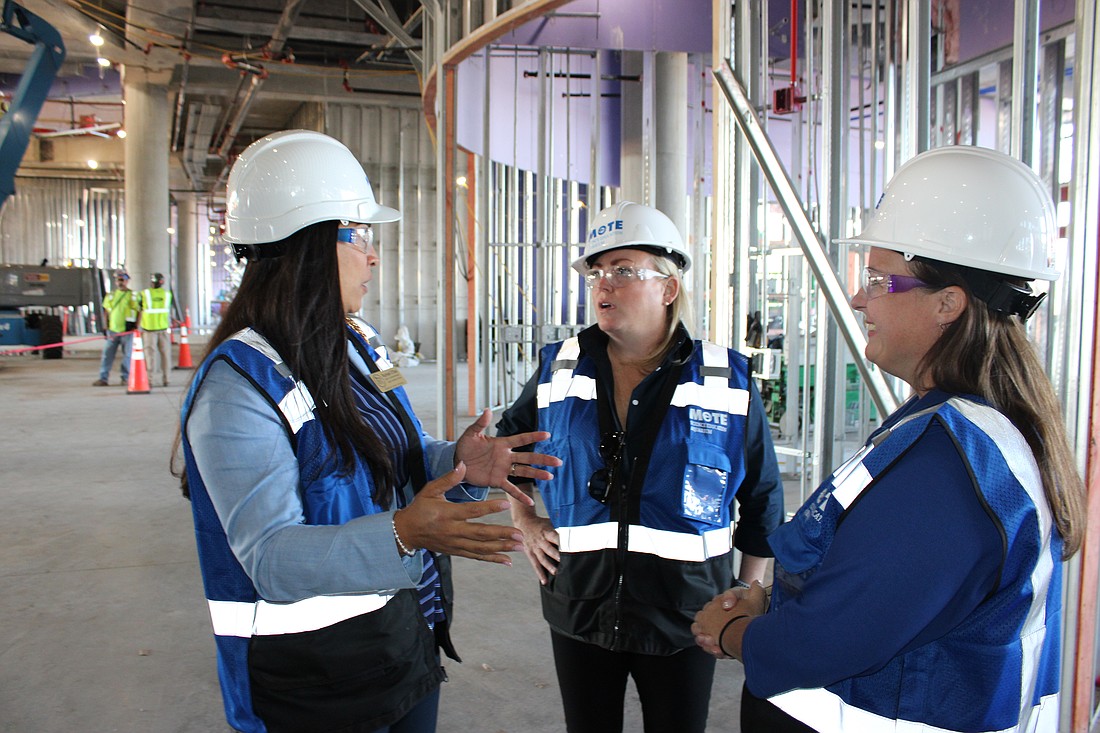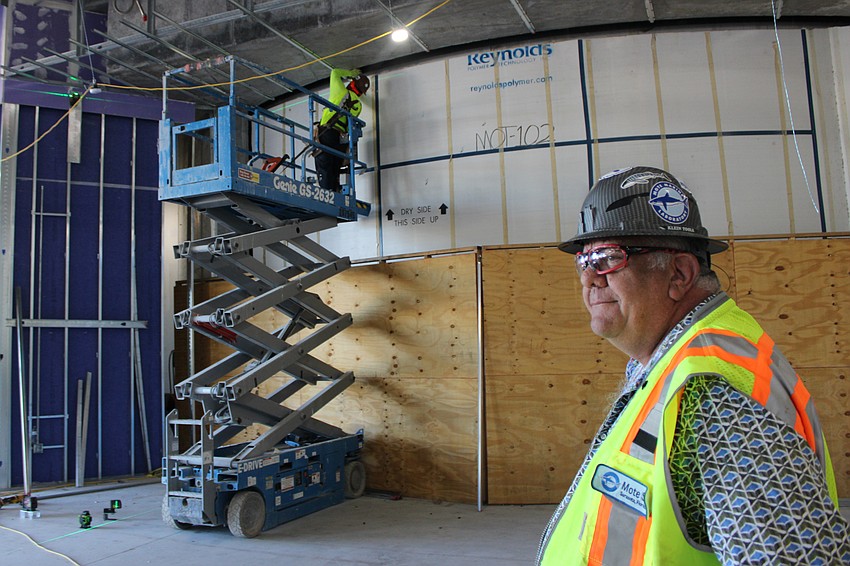- April 29, 2024
-
-
Loading

Loading

With representatives of the Sarasota County School District and the School District of Manatee County on hand, the Mote Science Education Aquarium held a walk-through for the media April 5 that was all about numbers.
The educators were most interested in the number 92,000, which is approximately the combined number of students in the two districts.
Amber Platowski, the curriculum coordinator for the School District of Manatee County, and Rachael O'Dea, Sarasota deputy superintendent and chief Academic Officer for the Sarasota County School District, said they will do everything possible to get all the students (approximately 50,000 in Manatee and 42,000 in Sarasota) to the aquarium after it opens. The target date for opening is February 2025.
Making that quest to expose every local student to the aquarium more feasible, the educators said, is the better accessibility of the new aquarium as opposed to Mote's City Island facility. Located just off Interstate 75 adjacent to Nathan Benderson Park, the Science Education Aquarium will offer fewer traffic problems that will allow the students to spend less time on the bus and more at the aquarium.
"This will be a much larger facility that can handle more students," Platowski said. "And their (three) learning labs have expanded our programs."
The Marine Ecology Lab, the Biomedical/Immunology Lab and the Ocean Technology Lab will offer students new opportunities in various disciplines.
"We say animals, microscopes and robots," said Aly Busse, Mote's associate vice president of education, in coming up with a short explanation of the purpose of the three labs.
The Marine Ecology Lab will feature animal habitats and contain tanks with marine life that will give the students hands-on experiences. The Biomedical/Immunology Lab will investigate new medicinal compounds from the ocean while exploring conservation-related questions. The Ocean Technology Lab will allow the students to test autonomous underwater vehicles, tools and equipment.

Each lab will accommodate 32 students at a time, and if you consider three field trips for each lab per day, that figures to be just under 300 students per day in the labs.To accommodate 92,000 students, that would take 306 days, which means that the districts will need to be creative to get all K-12 students some exposure to the aquarium over the course of a school year.
That exposure doesn't necessarily mean time at one of the labs. Perhaps it will be just a visit or a tour.
Platowski said all students, no matter the grade, will benefit from the Science Education Aquarium. She said, for the older students, that could even mean mentorships with a scientist or a biologist.
"It is going to be a great opportunity for all grades," she said.
Platowski said the school districts have been working with Dr. Kristen Ranges, who is the Mote SEA coordinator. According to a Mote's release, Ranges' role is to conduct a needs assessment for local high schools "to create accessible, engaging, inclusive, and comprehensive science curricula for programs administered at Mote's SEA teaching laboratories. Her goal is to provide hands-on marine science education and demonstrate the exciting potential and attainability of a future career in science."
"Mote has been coming to our schools, talking with our directors of curriculum," Platowski said. "Our science teachers have been doing focus groups."
Paltowski has been a marine and environmental science teacher at both Manatee High and Booker High. She just smiles when she considers the possibilities.
Paltowski, O'Dea and Busse stood in front of the areas that will become the labs and talked excitedly about those possibilities.
"As the spaces are filling out, you can visualize everything," Busse said. "We want the students to know that oceans are a place for them, ... aquariums are a place for them."
"This is an exceptional situation, that our kids will be exposed to this," O'Dea said. "It will bring our curriculum to life. We are planning with Mote's leadership to bring this into our curriculum."
Busse said besides the wildlife, and scientists and biologists, the students will be exposed to high-tech equipment that has been purchased for all three labs.
"These will be state-of-the-art science labs," she said. "This isn't available anywhere else. This is being built for what (the administrators) are doing, to meet the needs of the students."
O'Dea said the schools eventually will produce future marine scientists and biologists.
"That is the plan," she said "We need to feed that industry. We need to expose our students to job offerings."
Busse said it is all about igniting the students' curiosity which will allow them to understand the conservation of the marine ecosystems in their own backyards.
In addition to the learning labs, the Science Education Aquarium will have four Workforce Development Labs on the second and third floors of the aquarium — the Aquaculture and Fisheries Lab, the Conservation Lab, the Coral Lab, and the Veterinary Clinic and Diagnostic Center.
Interns and program participants — who will include high school students, undergraduate and graduate students — will gain technical skills, hands-on research experience and career-building networking opportunities by working alongside Mote scientist mentors.
Another number that is important to the school districts is zero. That will be the cost for students to visit. Previously at the City Island facility, it cost $18 per student to visit on a field trip.
Dan Bebak, the vice president of Mote Education, Aquarium and Facilities, said it was important for Mote to clear the way for free visits.
"Teaching labs are ingrained in our DNA," he said of Mote staff members.
While the educators talked about how the aquarium would affect students, Bebak was talking the nuts and bolts of the project. He said the number of workers on site would double to over 300 in another month as the interior work ramps up on projects such as aquatic habitats and placing trees and coral.

He said all the tanks are in place and currently are being water tested.
He said the exterior panels are being applied and he expects the exterior "skin" to have a finished look by the end of May.
With the focus on the new aquarium, Bebak said no "concrete plans" have been made for the City Island facility.
"We just need a couple of more months to talk about it," he said.
Even if the facility transforms to mostly a research facility, Bebak said there is likely to still be some sort of visitation or tour component. However, he said it isn't as likely to be as extensive as before.
As always, there remains another important number, the one to do with financing. Michael Moore, Mote's special advisor to the office of the president, said there have been some exciting developments in contributions and sponsorships.
"In the next week, we are having meetings with two major companies, one an international company," Moore said of possible sponsorships. "It fits with their core values.
"And we are excited just about the way people have been responding. We are giving a lot of tours. We have been talking about naming rights and promoting their brands. Corporations four years ago didn't want to talk to me, but now they can see (the structure coming to fruition)."
Moore said Mote has received commitments for $108 million of the $132 million needed for the project. While many of the government contributions or grants have been secured — such as $20 million from Sarasota County and $5 million from Manatee County — a major state source of funding is still being pursued. He said Mote's quest to secure federal funding has mostly been rejected.
He said Mote is hoping for a ribbon-cutting at the end of February 2025.
"This is a giving community," he said. "More than half the donors are new to Mote."